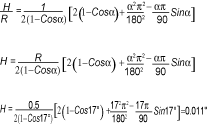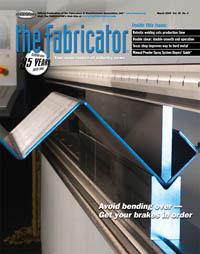- FMA
- The Fabricator
- FABTECH
- Canadian Metalworking
Categories
- Additive Manufacturing
- Aluminum Welding
- Arc Welding
- Assembly and Joining
- Automation and Robotics
- Bending and Forming
- Consumables
- Cutting and Weld Prep
- Electric Vehicles
- En Español
- Finishing
- Hydroforming
- Laser Cutting
- Laser Welding
- Machining
- Manufacturing Software
- Materials Handling
- Metals/Materials
- Oxyfuel Cutting
- Plasma Cutting
- Power Tools
- Punching and Other Holemaking
- Roll Forming
- Safety
- Sawing
- Shearing
- Shop Management
- Testing and Measuring
- Tube and Pipe Fabrication
- Tube and Pipe Production
- Waterjet Cutting
Industry Directory
Webcasts
Podcasts
FAB 40
Advertise
Subscribe
Account Login
Search
A good start makes a difference
How to set the entrance guide elevation for best results in roll forming
- By Hanhui Li and Kuang-Xu Li
- March 8, 2005
- Article
- Roll Forming
 |
| Fig. 1shows elevation of the entrance guide affects the sectional curvature. Fig. 2shows an Edge Bent Down Model. |
In a roll forming line, the entrance guide serves to guide the metal strip into the roll former at the optimum angle and elevation.
To achieve the correct feeding angle, the entrance guide should be parallel to the metal forming direction. Any horizontal rotation will push the strip off-center horizontally. The correct elevation can eliminate additional stress and strain at the edges of the metal strip and can reduce the distance between the entrance guide and the first pass.
Figure 1illustrates the relationship between the elevation of the entrance guide and the sectional curvature before and after the first pass. In the top drawing, the entrance guide is too high. The metal may curve up after coming out of the first pass. In the bottom drawing, the entrance guide is too low, which could cause the metal to curve down after coming out of the first pass. When the entrance guide is set at the correct elevation, as shown in the middle drawing, no additional elongation occurs at the edge section, and the metal will be flat out of the first pass, without bow or twist.
A calculation method is available to estimate the best elevation of the entrance guide. This method is based on both the bending corner
AD and the side edge BC having the same traveling distance from the entrance guide to the first pass—in other words, AD and BC are the same length (seeFigure 2).
Edge Bent Down Model
Figure 2 shows the edge bent down model. The equation when AD and BC are the same length is:
 |
For example, assume the width of channel side L is 0.800 inch, and the channel side is formed 17 degrees at the first pass. The elevation of the entrance guide H should be calculated by Equation 1 as the edge bent down model.
 |
Thus, the elevation of the entrance guide H should be 0.114 in.
 |
Figure 3is a table of coefficient (H/L) for the edge bent down model. For example, assume the width of channel side L is 0.800 in. and the channel side is formed 25 degrees at the first pass. From Figure 3, when the forming angle a is 25 degrees, the coefficient (H/L) is 0.201.
 |
The elevation of the entrance guide H, then, should be set to 0.161 in.
From Figure 3, when the forming angle a at the first pass is 90 degrees, the elevation of the entrance guide should be zero in height.
Edge Bent up Model
Figure 4shows the edge bent up model. The equation when AD and BC are the same length is:
 |
 |
| Fig. 4shows Edge Bent Up Model. Fig. 6shows an Arc Edge Bent Up Model. Fig. 8shows an Arc edge Bent Down Model. |
For example, assume the width of channel side L is 0.800 in., and the channel side is formed 17 degrees at the first pass. The elevation of the entrance guide H should be calculated by Equation 2 as the edge bent up model.
 |
The elevation of the entrance guide H, then, should be 0.120 in.
 |
Figure 5is a table of coefficient (H/L) for the edge bent up model. For example, assume the width of channel side L is 0.800 in., and the channel side is formed 25 degrees at the first pass. From Figure 5, when the forming angle a is 25 degrees, the coefficient (H/L) is 0.222.
 |
The elevation of the entrance guide H, then, should be set to 0.178 in.
From Figure 5, when the forming angle a at the first pass is 90 degrees, the coefficient (H/L) is 1.000. The elevation of the entrance guide H should be L (H = L) in. in height.
Arc Edge Bent up Model
Figure 6shows the arc edge bent up model. The equation when AD and BC are the same length is:
 |
For example, assume the forming angle is 17 degrees, with a 0.500-in. radius at the first pass. The elevation of the entrance guide H should be calculated by Equation 3 as the arc edge bent up model.
 |
The elevation of the entrance guide H, then, should be 0.011 in.
 |
Figure 7is a table of coefficient (H/R) for an arc edge bent up model. For example, assume the formed angle is 45 degrees, with radius 0.8 in. at the first pass. From Figure 7, when forming angle a is 45 degrees, the coefficient (H/R) is 0.157. The elevation of the entrance guide H is:
 |
The elevation of the entrance guide H, then, should be set to 0.126 in.
Arc Edge Bent Down Model
Figure 8shows the arc edge bent down model. The equation when AD and BC are the same length is:
 |
For example, the forming angle is 17 degrees, with a 0.500-in. radius at the first pass. The elevation of the entrance guide H should be calculated by Equation 4 as the arc edge bent down model.
 |
The elevation of the entrance guide H, then, should be 0.011 in.
 |
Figure 9is a table of coefficient (H/R) for arc edge bent down model. For example, assume the forming angle is 45 degrees, with radius 0.8 in. at the first pass. From Figure 9, when the forming angle a is 45, the coefficient (H/R) is 0.136. The elevation of the entrance guide H is:
 |
Keep It Flat
By ensuring your entrance guide is set to the correct elevation, you can reduce the stress and strain on formed parts and reduce the longitudinal elongation differential in the cross section. The correct elevation of the entrance guide will form metal flat out of the first pass. The straight metal can easily self-thread, getting into the second pass without any assistance.
The entrance guide isn't a direct forming tool, but as the starting point of the forming process, it is a very important accessory. A good start will make the whole forming process run more smoothly.
Hanhui Li is senior engineer with Worthington Armstrong Venture (WAVE), 9 Old Lincoln Highway, Suite 200, Malvern, PA 19355, 610-722-1232, fax 610-722-1246, hanhui_ li@armstrong.com.
Kuang-Xu Li is senior physicist at Wuhan High School, Liang-Dao St., Wu-Chang District, Wuhan, Wubei Province, P.R. China, 86-27-8884-5737.
Related Companies
subscribe now

The Fabricator is North America's leading magazine for the metal forming and fabricating industry. The magazine delivers the news, technical articles, and case histories that enable fabricators to do their jobs more efficiently. The Fabricator has served the industry since 1970.
start your free subscription- Stay connected from anywhere

Easily access valuable industry resources now with full access to the digital edition of The Fabricator.

Easily access valuable industry resources now with full access to the digital edition of The Welder.

Easily access valuable industry resources now with full access to the digital edition of The Tube and Pipe Journal.
- Podcasting
- Podcast:
- The Fabricator Podcast
- Published:
- 04/16/2024
- Running Time:
- 63:29
In this episode of The Fabricator Podcast, Caleb Chamberlain, co-founder and CEO of OSH Cut, discusses his company’s...
- Trending Articles
AI, machine learning, and the future of metal fabrication

Employee ownership: The best way to ensure engagement

Steel industry reacts to Nucor’s new weekly published HRC price

Dynamic Metal blossoms with each passing year

Metal fabrication management: A guide for new supervisors

- Industry Events
16th Annual Safety Conference
- April 30 - May 1, 2024
- Elgin,
Pipe and Tube Conference
- May 21 - 22, 2024
- Omaha, NE
World-Class Roll Forming Workshop
- June 5 - 6, 2024
- Louisville, KY
Advanced Laser Application Workshop
- June 25 - 27, 2024
- Novi, MI


























